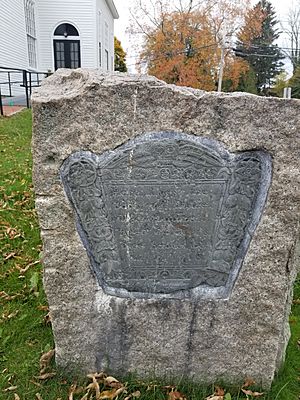Daniel Takawambait facts for kids
Daniel Takawambait (born around 1652, died 1716) was a very important Native American leader. He is thought to be the first Native American Christian pastor in North America. He served a church in a special community called a "praying town" in Natick, Massachusetts. These towns were places where Native Americans who had converted to Christianity lived.
Daniel Takawambait was a pastor from 1683 until his death in 1716. He also worked hard to protect the land rights of Native American people in colonial Massachusetts. He even wrote at least one book or paper.
Contents
Early Life and Church Work
Daniel Takawambait was born around 1652. His family belonged to the Nipmuc people. When he was young, he met a missionary named John Eliot. Eliot was known for working with Native Americans. Daniel might have even studied at Harvard's Indian College.
In 1674, a man named Daniel Gookin wrote about Daniel. He said that Daniel was a "sober and pious young man" who was chosen to be a minister for a community called Quantisset. The people there accepted him. In 1676, Daniel Takawambait signed a request with other Native Americans. They asked for a young Native American man named Peter to be set free from prison.
After a conflict known as King Philip's War, Daniel Takawambait became an ordained pastor around 1681. Around this time, another pastor, Daniel Gookin, Jr., started preaching in English at the Natick Indian church. This was difficult because the Nipmuc people needed a translator.
In 1683, the Native American church members, including Daniel Takawambait, asked John Eliot for help. They wanted services to continue in the Nipmuc language. They suggested that Gookin learn their language or use a local interpreter. Soon after, in 1683, the Natick Praying Town chose Daniel Takawambait as their second minister. He took over from John Eliot.
In 1685, Daniel Takawambait wrote down the last words of several Native American church members. These speeches were in their native language. John Eliot then translated them into English. They were published in a pamphlet called "Dying Speeches and Counsels Of such Indians as dyed in the Lord."
Protecting Native American Land
Besides being a pastor, Daniel Takawambait was an important leader in his community. He signed and witnessed many official papers about Native American land deals.
Between 1681 and 1685, Daniel Takawambait signed documents with other Nipmuc people. They were protesting the sale of tribal lands. These lands were near what is now Marlborough, Massachusetts and other areas in "Nipmuc country." Some Native American individuals were selling land without proper authority. Daniel Takawambait worked to stop these sales. He also witnessed a deed in 1684 for lands in Sudbury and what is now Maynard, Massachusetts.
After King Philip's War, some Native Americans who had been sent away returned to Natick. One of them was Sagamore George, who had been sent to Barbados. In 1686, after George died, Daniel Takawambait gave a statement. He explained that Sagamore George had lived and died at the home of James Rumley Marsh. He also said that George left all his land to his relative, James Rumley Marsh. In 1692, Daniel Takawambait also transferred some Natick land to the Sawin family.
Later Years and Passing
By 1699, many people in Daniel Takawambait's church had either died or left Natick. Many were poor and needed to live among English settlers to support themselves. The original church building, built in 1651, was also falling apart. The church members asked the government for permission to sell some land. They wanted to use the money to hire a carpenter to rebuild the church.
In 1698, two white pastors visited Takawambait's church. They noted that only a small church remained with ten official members. However, they said that Daniel Takawambait was "a person of great knowledge." Even though he was skilled in languages and Christian teachings, some Puritan church leaders worried. They thought Daniel might have included some Native American traditions in the church services.
By 1712, some colonial religious leaders, like Cotton Mather, were concerned. They felt the church had become much smaller. They even talked about removing Daniel Takawambait. They blamed him and the church's rules for the decrease in members.
Despite these concerns, Daniel Takawambait continued to serve as Natick's pastor until he died in 1716. He was one of the few Native Americans buried in the English style, with a headstone and a footstone. Today, his headstone can still be seen next to the Eliot Church in Natick. It was moved a few feet from its first spot. His footstone was also moved and placed into the Bacon Free Library building.
His Lasting Impact
After Daniel Takawambait passed away, the New England Company chose another Native American pastor. This was John Neesnumin of Sandwich, in 1717. But he died two years later, and the church mostly ended soon after.
Today, Daniel Takawambait's pulpit desk is on display at the Natick Historical Society Museum. Members of his church built it. It is one of the oldest examples of furniture made by Native Americans that we still have. In the 1800s, a local group in Natick was named in honor of Takawambait.



